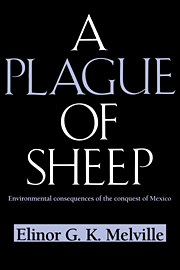Book contents
- Frontmatter
- Contents
- Illustrations and Tables
- Preface
- Chapter 1 Introduction
- Chapter 2 Alien Landscapes
- Chapter 3 The Australian Experience
- Chapter 4 The Mexican Case
- Chapter 5 The Conquest Process
- Chapter 6 The Colonial Regime
- Appendix A Sub-Areas
- Appendix B Population Estimates
- Appendix C Sources for Land Holding and Land Use
- Abbreviations
- Glossary
- Bibliography
- Index
Chapter 6 - The Colonial Regime
Published online by Cambridge University Press: 05 August 2012
- Frontmatter
- Contents
- Illustrations and Tables
- Preface
- Chapter 1 Introduction
- Chapter 2 Alien Landscapes
- Chapter 3 The Australian Experience
- Chapter 4 The Mexican Case
- Chapter 5 The Conquest Process
- Chapter 6 The Colonial Regime
- Appendix A Sub-Areas
- Appendix B Population Estimates
- Appendix C Sources for Land Holding and Land Use
- Abbreviations
- Glossary
- Bibliography
- Index
Summary
By 1600 the era of conquest was over in most parts of the Central Highlands of New Spain and a remarkably stable colonial regime was in place, typified by the rural system of production – the hacienda. Our understanding of the nature of the hacienda, its internal structure and its relations with Indian communities, towns, and evolving internal and international markets has undergone a transformation of its own as research carried out over the past twenty years produced a profusion of variants of the hacienda. It is no longer possible to sustain the traditional conceptualization of the colonial hacienda as a large, underexploited, undercapitalized estate that produced for subsistance and existed primarily for the prestige of its owner. Regional and hacienda studies have shown that while there were indeed huge haciendas in some regions, in others they were not much bigger than labores; that haciendas often required considerable working capital; that hacienda owners were intimately concerned with production for the market; and that rather than depending solely on debt peonage, haciendas combined a variety of methods to recruit and maintain labor such as repartimiento, slavery, wage labor, and sharecropping. One way out of the conceptual dilemma posed by the evidence of variability has been to shift the focus from the hacienda to its context, and analysts have, in Eric Van Young's words, come to treat the hacienda as an effect rather than a cause.
- Type
- Chapter
- Information
- A Plague of SheepEnvironmental Consequences of the Conquest of Mexico, pp. 151 - 166Publisher: Cambridge University PressPrint publication year: 1994

